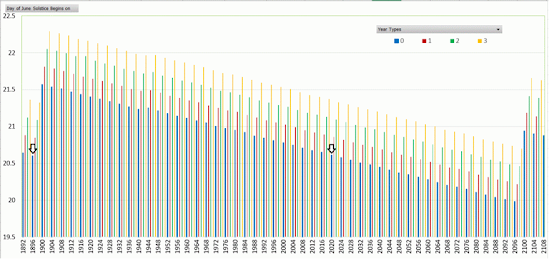Happy Thought for 21 June
Have a Happy
Thought:
In most years, the
solstice hits on the calendar date of June 22nd in New Zealand. But
this year, it’s a bit earlier.
- The
solstice occurs when the Earth’s poles are most directly pointed toward
(or away) from the sun. Because it’s the North Pole that’s pointed toward
the sun right now, it’s summer solstice in the northern hemisphere. And
winter solstice in the southern hemisphere, because we’re pointed away
from the sun.
- The
solstice is when you get the longest night and shortest day of the year
(winter)… or vice versa (summer).
- Equinox
(think: equal) is midway in between the winter and summer solstices. So
they happen in the midst of spring and autumn, and tend to have equal
amounts of day and night.
Solstice dates in Vancouver, British Columbia, Canada, classified by “type” (the remainder after dividing the year by 4). Years evenly divisible by 4 (type 0 – such as 2016, 2020, 2024) can have early solstices. Credit: Milan B/RASC Vancouver
But of course it
all gets even more complicated because the Earth’s rotational speed (length of
a day) changes. It does this quite a bit, actually! A lot of the variability is
down to tides (so yes, “time and tides” are very much connected!), since tides
are really the effect of gravity from the sun and the moon, tugging the Earth
around a bit.
Some of the variability is also down to how the Earth’s core is spinning – and we can figure this out by watching changes in the Earth’s magnetic fields.
Recent changes in spin caused by
ice and iron
In any case:
If you’re in the
Northern Hemisphere, get out and enjoy those long days (stick to morning and
evening if you’re in a heat wave area though!!)
If you’re in the
Southern Hemisphere: the longest dark has passed, and summer is coming.
You can read more
about leap years and days and why they do this 4, 100, and 400 year cycle here:
https://bigthink.com/starts-with-a-bang/summer-solstice-earliest-since-1796/
And more about why we might need
a negative leap second, here: https://www.nature.com/articles/s41586-024-07170-0



Comments
Post a Comment
Thank you, we love reading your comments!